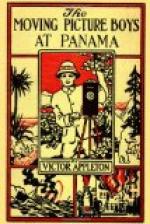“Oh, so you found it,” said the Spaniard. “Well, even if it had gone off there wouldn’t have been much of an explosion.”
“It’s easy enough to say that—now,” declared the captain.
But later, when they followed up the wires which Blake had severed, which had run from the brass-bound box to a point near the spillway of the dam, it was found that only a small charge of dynamite had been buried there—a charge so small that it could not possibly have done more than very slight damage to the structure.
“I can’t understand it,” said Captain Wiltsey. “They could just as well have put a ton there, and blown the place to atoms, and yet they didn’t use enough to blow a boulder to bits. I don’t understand it.”
“But why should Mr. Alcando try to blow up the dam at all?” asked Blake, “That’s what I can’t understand.”
But a little later they did, for the Spaniard confessed. He had to admit his part in the plot, for the moving pictures, made by the automatic camera, were proof positive that he was the guilty one.
“Yes, it was I who tried to blow up the dam,” Alcando admitted, “but, as you have seen, it was only to be an attempt to damage it. It was never intended to really destroy it. It was an apparent attempt, only.”
“But what for?” he was asked.
“To cause a lack of confidence in the Canal,” was the unexpected answer. “Those I represent would like to see it unused. It is going to ruin our railroad interests.”
Then he told of the plot in detail.
Alcando was connected, as I have told you, with a Brazilian railroad. The road depended for its profits on carrying goods across South America. Once the Canal was established goods could be transported much more cheaply and quickly by the water route. The railroad owners knew this and saw ruin ahead of them if the Canal were to be successful. Consequently they welcomed every delay, every accident, every slide in Culebra Cut that would put off the opening of the great waterway.
But the time finally came when it was finished, and a success. Then one of the largest stockholders of the railroad, an unprincipled man, planned a plot. At first his fellow stockholders would not agree to it, but he persuaded them, painting the ruin of their railroad, and saying only slight damage would be done to the Canal.
His plan was to make a slight explosion, or two or more of them, near Culebra Cut or at the great dam. This, he anticipated, would cause shippers to regard the Canal with fear, and refuse to send their goods through it. In that way the railroad would still hold its trade.
Alcando was picked for the work. He did not want to undertake it, but he was promised a large sum, and threats were made against him, for the originator of the plot had a certain hold over him.




